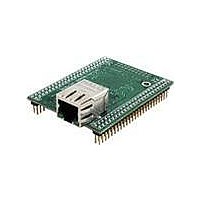MOD5234-100IR NetBurner Inc, MOD5234-100IR Datasheet - Page 403

MOD5234-100IR
Manufacturer Part Number
MOD5234-100IR
Description
MOD5234 10/100 ETHERNET MODULE
Manufacturer
NetBurner Inc
Type
Controllers & Processorsr
Datasheets
1.MOD5272-100IR.pdf
(3 pages)
2.MOD5234-100IR.pdf
(4 pages)
3.MOD5234-100IR.pdf
(754 pages)
Specifications of MOD5234-100IR
Interface
I²C, SPI, UART
Voltage - Supply
2.5V
Mounting Type
Surface Mount
Package / Case
Module
Product
Modules
Lead Free Status / RoHS Status
Lead free / RoHS Compliant
Data Format
-
Baud Rates
-
Lead Free Status / Rohs Status
Lead free / RoHS Compliant
Other names
Q4483564
- Current page: 403 of 754
- Download datasheet (13Mb)
Functional Description
In MII mode, the receiver checks for at least one byte matching the SFD. Zero or more PA bytes
may occur, but if a 00 bit sequence is detected prior to the SFD byte, the frame is ignored.
After the first 6 bytes of the frame have been received, the FEC performs address recognition on
the frame.
Once a collision window (64 bytes) of data has been received and if address recognition has not
rejected the frame, the receive FIFO is signalled that the frame is “accepted” and may be passed
on to the DMA. If the frame is a runt (due to collision) or is rejected by address recognition, the
receive FIFO is notified to “reject” the frame. Thus, no collision fragments are presented to the
user except late collisions, which indicate serious LAN problems.
During reception, the Ethernet controller checks for various error conditions and once the entire
frame is written into the FIFO, a 32-bit frame status word is written into the FIFO. This status word
contains the M, BC, MC, LG, NO, CR, OV and TR status bits, and the frame length. See
Section 19.3.14.2, “ Reception
Errors” for more details.
Receive Buffer (RXB) and Frame Interrupts (RFINT) may be generated if enabled by the EIMR
register. A receive error interrupt is babbling receiver error (BABR). Receive frames are not
truncated if they exceed the max frame length (MAX_FL); however, the BABR interrupt will
occur and the LG bit in the Receive Buffer Descriptor (RxBD) will be set. See
Section 19.2.5.2,
“Ethernet Receive Buffer Descriptors (RxBD0 &
RxBD1)” for more details.
When the receive frame is complete, the FEC sets the L-bit in the RxBD, writes the other frame
status bits into the RxBD, and clears the E-bit. The Ethernet controller next generates a maskable
interrupt (RFINT bit in EIR, maskable by RFIEN bit in EIMR), indicating that a frame has been
received and is in memory. The Ethernet controller then waits for a new frame.
The Ethernet controller receives serial data lsb first.
19.3.8 Ethernet Address Recognition
The FEC filters the received frames based on destination address (DA) type — individual
(unicast), group (multicast), or broadcast (all-ones group address). The difference between an
individual address and a group address is determined by the I/G bit in the destination address field.
A flowchart for address recognition on received frames is illustrated in the figures below.
Address recognition is accomplished through the use of the receive block and microcode running
on the microcontroller. The flowchart shown in
Figure 19-27
illustrates the address recognition
decisions made by the receive block, while
Figure 19-28
illustrates the decisions made by the
microcontroller.
If the DA is a broadcast address and broadcast reject (RCR[BC_REJ]) is deasserted, then the frame
will be accepted unconditionally, as shown in
Figure
19-27. Otherwise, if the DA is not a broadcast
address, then the microcontroller runs the address recognition subroutine, as shown in
Figure
19-28.
MCF5235 Reference Manual, Rev. 2
Freescale Semiconductor
19-39
Related parts for MOD5234-100IR
Image
Part Number
Description
Manufacturer
Datasheet
Request
R

Part Number:
Description:
MCU, MPU & DSP Development Tools MOD5234 MODULE
Manufacturer:
NetBurner Inc
Datasheet:

Part Number:
Description:
MCU, MPU & DSP Development Tools MOD5234 Core Module Development Kit
Manufacturer:
NetBurner Inc
Datasheet:

Part Number:
Description:
BOARD SERIAL-ETHERNET 512K FLASH
Manufacturer:
NetBurner Inc
Datasheet:

Part Number:
Description:
PROCESSOR MODULE FLASH MOD5272
Manufacturer:
NetBurner Inc
Datasheet:

Part Number:
Description:
PROCESSOR MODULE 512KB FLASH
Manufacturer:
NetBurner Inc
Datasheet:

Part Number:
Description:
DUAL PORT SERIAL-ETHERNET
Manufacturer:
NetBurner Inc
Datasheet:

Part Number:
Description:
PROCESSOR MODULE FLASH
Manufacturer:
NetBurner Inc
Datasheet:

Part Number:
Description:
PROCESSOR MODULE 512KB FLASH
Manufacturer:
NetBurner Inc
Datasheet:

Part Number:
Description:
KIT DEVELOP NETWORK FOR MOD5282
Manufacturer:
NetBurner Inc
Datasheet:

Part Number:
Description:
KIT DEVELOP NETWORK FOR MOD5272
Manufacturer:
NetBurner Inc
Datasheet:

Part Number:
Description:
DUAL PORT SERIAL-ETHERNET
Manufacturer:
NetBurner Inc
Datasheet:

Part Number:
Description:
Ethernet Modules & Development Tools 32 Bit 66MHz 40 Pin DIP Industrial Temp
Manufacturer:
NetBurner Inc
Datasheet:

Part Number:
Description:
Ethernet ICs 32bit 147MHz CAN-to- Ethnt Device IndTemp
Manufacturer:
NetBurner Inc
Datasheet:










